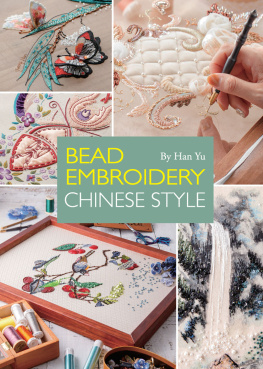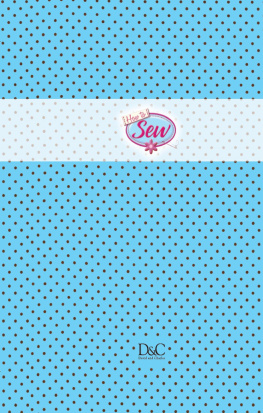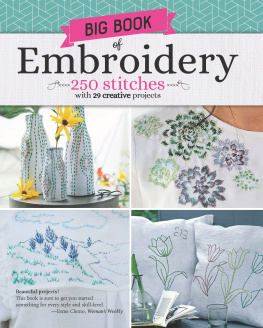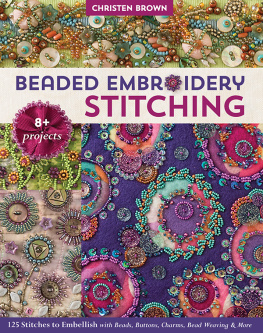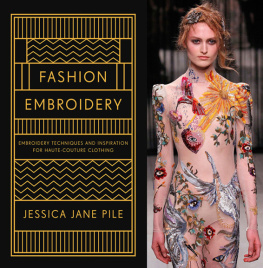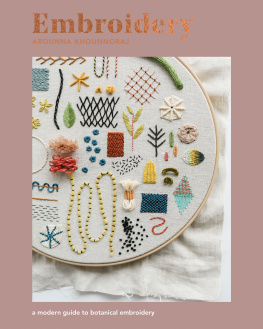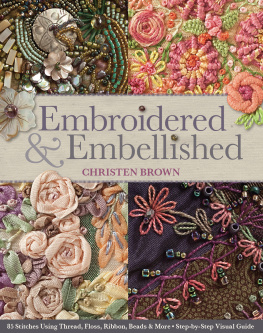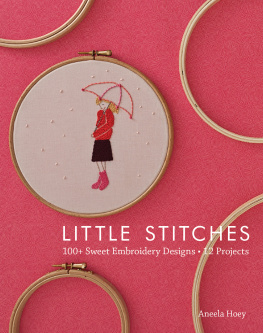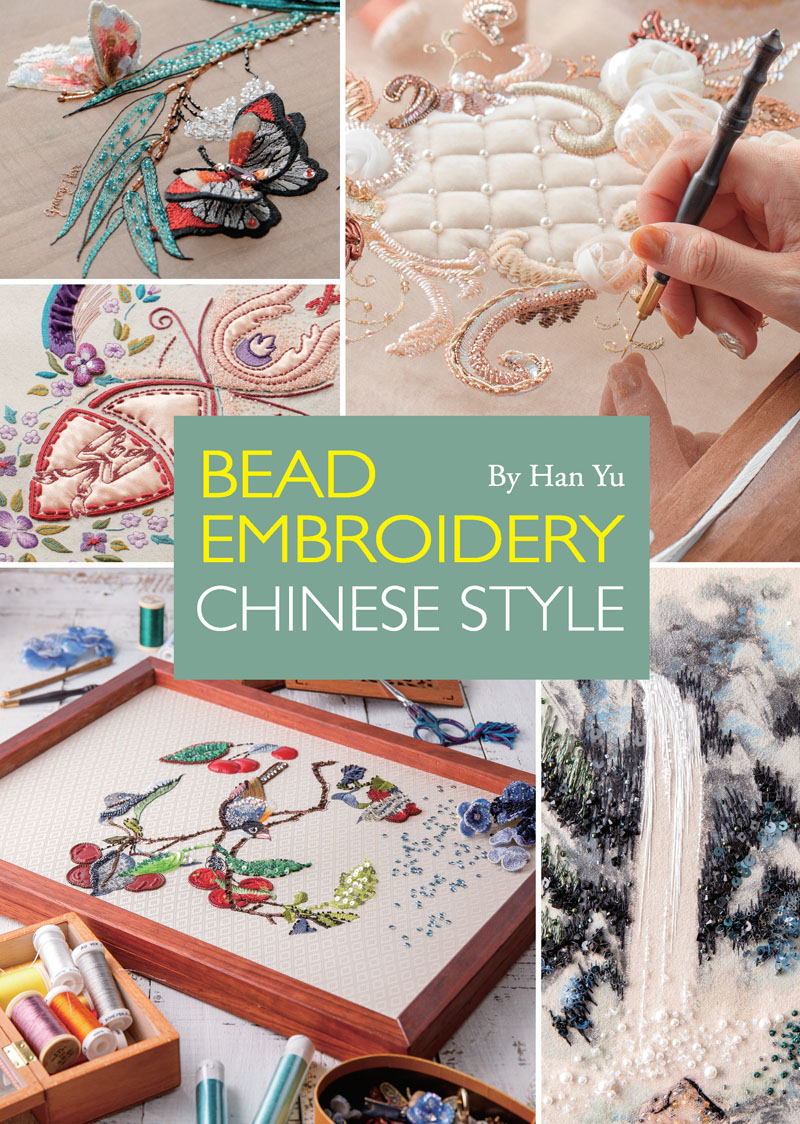

Fig. 1 The bead embroidery incorporates diverse materials including organza, velvet, bullion wires, pearls, beads, sequins, etc.
Fig. 2 Section of the embroidery Bird and Red Berries. For the complete work, please see .
Copyright 2019 Shanghai Press and Publishing Development Co., Ltd.
All rights reserved. Unauthorized reproduction, in any manner, is prohibited.
This book is edited and designed by the Editorial Committee of Cultural China series.
For Gracey Han Studio
Project Designers and Text: Han Yu, Wang Yuxi, Wu Qiong, Wu Yingwen, He Jiahui, Liu Wenbin
Photographs: Geng Qiannan, Wu Yingwen
Digital Drawing: Xu Yijia
Translation: Wu Yanting
Cover Design: Wang Wei
Interior Design: Li Jing, Hu Bin (Yuan Yinchang Design Studio)
Editor: Cao Yue
Editorial Director: Zhang Yicong
Senior Consultants: Sun Yong, Wu Ying, Yang Xinci
Managing Director and Publisher: Wang Youbu
ISBN: 978-1-60220-038-8
Address any comments about Bead Embroidery: Chinese Style to:
Better Link Press
99 Park Ave
New York, NY 10016
USA
or
Shanghai Press and Publishing Development Co., Ltd.
F 7 Donghu Road, Shanghai, China (200031)
Email:
Printed in China by Shenzhen Donnelley Printing Co., Ltd.
3 5 7 9 10 8 6 4 2

Fig. 3 Bead embroidery on wooden suitcases.
CONTENTS

Fig. 4 Metallic threads.

Fig. 5 Bauhinia Blakeana
This embroidery applies different shades of purple, pink and white to depict the simple but elegant flower of Bauhinia blakeana (or Hong Kong orchid tree flower). In Chinese literature, this flower is also used to express ones longing for the loved ones.

Fig. 6 Leaves on a Winter Day
Royal blue is used here to depict the leaves of a tree on a winter day, which is elegant and unconventional.
PREFACE

Fig. 7 Bead embroidery work desk. At the bottom are hook needles.
I n my bead embroidery class, I found students generally fell into two categories: those who are interested in bead embroidery and want to enrich their lives by making with their own hands some of the small practical embroidery items, and those who work as designers in the textile industry and other related professions. Some would like to use bead embroidery for their haute couture or shoes and handbags, and others want to use it for custom-made luxurious wall paper and screens. Although embroidery is not as difficult as it seems, I find students who excel are always those who are patient, humble and have good aesthetic taste and creative energy, regardless of their original intentions.

Fig. 8 Small items of bead embroidery.
To learn bead embroidery, you must have patience: patience to learn and practice until you master the basic stitches with embroidery needles. Only after you have laid a solid foundation can you begin to use different techniques with ease and reach certain height through practicing. When you first take the needle in hand, you might think it is easy: a simple act of thread and needle. However, when you actually work with it, you will find it is not that easy to control the needle, in particular the French needle with a hook that catches easily on the fabric. Feeling downcast is not going to help. What you need is take your time and be extremely focused on your work. You should also have proper respect for beauty. All beginners should start with stitches using hand sewing needles. You must practice until you are at ease with controlling the space between beads or sequins before selecting a simple decorative item in the elementary coursework to embroider. When you finish your first piece of embroidery with your own hand, your confidence and interest will grow. Having mastered a variety of techniques, you will be able to create bead embroidery works of your own, from simple to more complicated ones.
Humility is the second quality that a good embroidery learner must have. Humility here means more than simply learning from your teachers and others about their skills, experiences and ways of thinking. It also means that you will learn from life and the natural world. If you want to embroider a landscape painting, for instance, your work will have to reflect the fluidity and lightness of water, and the mountain, by contrast, has to be solid and heavy. If you want to embroider a bird, you shall have a clear picture of its posture and which part you want to accentuate. It wont work if you make its wings the way as it is flying while making its body bulge as when it is sitting still. Such knowledge comes from your observation of everyday life. Mountains and waters, grass and flowers and birds, they all follow their natural paths of life so they exist harmoniously in this world. Try to feel with your heart the beauty of these things: their color, structure, proportion, and then ask yourself: what make them beautiful? You will also look at things that are not so beautiful, and ask yourself: why are they unpleasant to the eye? Is it a problem of proportion? Or is it because of a lack of focus? By so doing, you will learn to draw your own conclusions about the laws of harmony and beauty.

Fig. 9 Spools of threads.
Observation of daily life and the natural world is also an important way to elevate your aesthetic taste. Nature is generous in its offerings: the vibrant colors in summer, the lush green on the verge of bursting in spring, the orange, yellow and redcolors of harvest in the fall, and the silver-colored winter. You wont see anything if you are oblivious to your surroundings. Try to enjoy your life with your heart and soul; to feel the changing colors and shifting lights in nature. Besides, learning from the essence of both Eastern and Western cultures is also an effective way of elevating your aesthetics. To me, the Chinese culture is a treasury where I can draw inexhaustible resources, ranging from ancient legends and mythologies to the four arts of Chinese scholars (i.e., lute-playing, chess, calligraphy and painting); from historical tales to folk arts, from the poetic imagery of poetry and prose to the artistic conception of ink and wash paintings. All this that constitutes the extensive and profound, ancient and mystic nature of oriental culture came from things in the natural world and survived the turmoil of history and the test of time. Such colors, landscape and stories are ultimately melt into the work of an artists needles and threads. Vibrant and colorful threads and beads come alive on the fabric, recording the embroiderers reflection of the world and life. Works of art as such require both the work of the brain and the hands, but it is more demanding on the brain. Good aesthetic taste will help the designer truthfully transfer his or her conception to the embroidery. If you are like a sponge, willing to absorb beauty from all spheres of life, needles and threads will become your friend and your paint brush. With the assistance of your fingers, these tools will capture the inspirations that come to you and help you materialize the colorful dream of yours into a three-dimensional work of art on a tiny piece of fabric.
Next page
